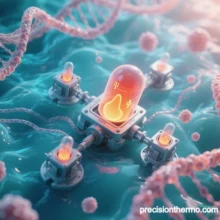
tRNA (Transfer RNA) in Developing Novel Therapeutics: Targeting Bacterial tRNA for Antibiotic Innovation
A Strategic Breakthrough Against Bacterial Core Life Processes and Drug Resistance
I. The Central Role of tRNA in Bacterial Survival and Targeting Advantages
tRNA is pivotal in protein synthesis, decoding mRNA codons into corresponding amino acids. Its functional integrity directly impacts bacterial growth, stress response, and virulence. Targeting tRNA-related pathways offers unique advantages:
- High Conservation: tRNA synthesis, modification, and maturation pathways are highly conserved across bacteria, enabling broad-spectrum antibiotic development.
- Bacterial Specificity: Structural and functional differences in tRNA-modifying enzymes (e.g., TrmD), amino acid-binding sites (e.g., aaRS catalytic domains), or features like the anticodon stem-loop reduce host toxicity.
- Multi-Target Potential: tRNA’s lifecycle—synthesis, modification, transport, and degradation—provides diverse therapeutic targets.
II. Strategies and Case Studies in tRNA-Targeted Antibiotics
1. Inhibiting tRNA-Modifying Enzymes
Bacterial tRNA contains 40–50 chemical modifications (e.g., methylation, thiolation) catalyzed by bacterial-specific enzymes:
- TrmD Inhibitors: Small-molecule inhibitors of tRNA-(N1G37) methyltransferase block m1G37 modification in Pseudomonas aeruginosa, causing translational errors and bacterial death.
- Targeting Thiolation: Inhibiting sulfurtransferase MnmA disrupts stress-response protein synthesis and enhances immune clearance.
2. Disrupting Aminoacyl-tRNA Synthesis (aaRS)
Aminoacyl-tRNA synthetases (aaRS) are validated antibiotic targets:
- Mupirocin: Targets Staphylococcus aureus IleRS, but rising resistance has spurred CRISPR-designed PheRS inhibitors for MRSA.
- Non-Hydrolyzable aa-AMP Analogs: Compounds like 5′-O-(N-L-tyrosyl)-sulfamoyl adenosine mimic reaction intermediates, achieving nanomolar inhibition of class I aaRS (e.g., LeuRS, IleRS).
3. Blocking tRNA Maturation and Function
- tRNA 3’-End Processing Inhibitors: Targeting RNase R in Mycoplasma genitalium disrupts precursor cleavage, collapsing translation.
- Anticodon Stem-Loop (ASL) Targeting: Compounds from Trana Discovery disrupt tRNA-mRNA codon pairing in Gram-negative pathogens without harming gut microbiota.
4. Countering tRNA-Mediated Drug Resistance
- Suppressing tRNA Upregulation: Blocking recombination enzymes (e.g., RecA) prevents tRNA overexpression under antibiotic stress, delaying resistance.
- Exploiting tRNA Modification Defects: Strains with impaired tRNA modifications exhibit defective efflux pumps, sensitizing them to traditional antibiotics.
III. Technological Breakthroughs and Innovative Approaches
1. High-Throughput Screening and Structural Biology
- CRISPRi Libraries: Pooled CRISPR interference screens identify targets like peptidyl-tRNA hydrolase (Pth) inhibitors.
- Cryo-EM and Quantum Computing: Resolving tRNA-ribosome complex dynamics (e.g., 23S rRNA peptidyl transferase center) guides macrolide antibiotic design.
2. AI-Driven Drug Design
- Generative Models: Predict tRNA-modifying enzyme-inhibitor interactions to optimize membrane penetration (e.g., Gram-negative outer membrane).
- Resistance Prediction: Machine learning links tRNA expression profiles to antibiotic susceptibility, guiding combination therapies (e.g., TrmD inhibitors + β-lactams).
3. Synthetic Biology Tools
- Self-Regulating Circuits: Engineered probiotics express tRNA fragments (tRFs) to disrupt pathogen translation and deliver antimicrobial peptides.
- Phage Delivery Systems: Bacteriophages encapsulate tRNA-targeting nucleases (e.g., Colicin E5) to degrade pathogenic tRNA in resistant infections.
IV. Challenges and Future Directions
1. Balancing Penetration and Selectivity
- Gram-Negative Barriers: Cationic peptide conjugates or nanocarriers enhance drug delivery across outer membranes.
- Mitochondrial tRNA Homology: Optimize inhibitor selectivity to avoid off-target effects on human mitochondrial aaRS.
2. Addressing Resistance Evolution
- Multi-Target Inhibitors: Combat mutations in tRNA-modifying enzymes (e.g., TrmD active-site variants) with polypharmacology.
- Epigenetic Editing: Suppress bacterial tRNA adaptive reprogramming.
3. Overcoming Clinical Translation Hurdles
- Biomarkers for Resistance: Develop tRNA modification profiles as early-warning indicators.
- Real-Time Monitoring: Fluorescent tRNA probes assess drug impact on bacterial translation in situ.
V. Conclusion
tRNA, a central hub of bacterial translation, offers a dual promise of broad-spectrum activity and precision in antibiotic development. By targeting modification enzymes, disrupting aaRS, blocking maturation, or countering resistance mechanisms, tRNA-focused therapies could overcome multidrug resistance. Integrating AI, synthetic biology, and advanced delivery systems will shift strategies from single-target inhibition to dynamic network modulation, ushering in an era of precision disruption of pathogen core machinery.
Data sourced from publicly available references. For inquiries, contact: chuanchuan810@gmail.com.






